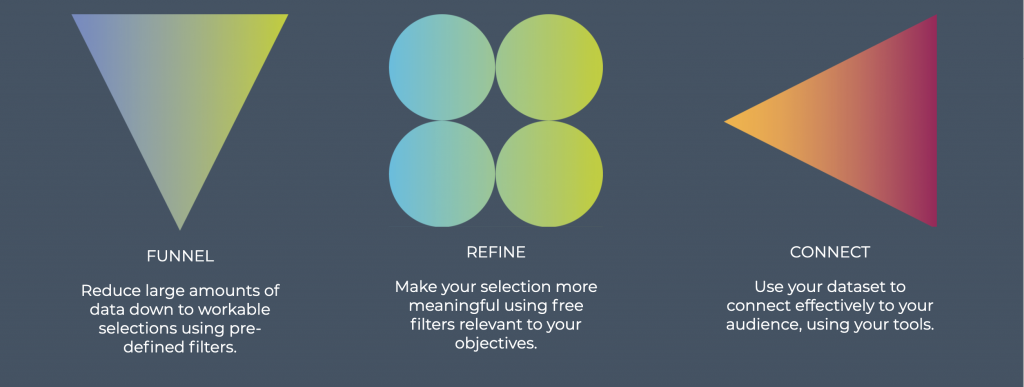Segmentation of UK businesses
A quick browse of the internet reveals countless articles and pages on ‘Marketing Segmentation’. Very few seem to focus on B2B marketing segmentation of UK businesses.
That’s what we are most concerned with here at DataEco – segmenting companies. Not consumers. How can we dig deeper into groups of companies that share similar traits, in order to market to them more effectively.
STP in marketing stands for Segmentation, Targeting, and Positioning. … The goal is to deliver relevant messages to commercially attractive audience segments. STP focuses on identifying the most valuable segments and then creating the right marketing mix and product positioning strategy (think 4Ps) for those segments. (Smart Insights)
No doubt that the B2B world has lots to learn from the consumer industries marketing. Accurate and reliable Segmentation is just as critical, if not more, for companies targeting other businesses. The principles are the same but they need to be applied slightly differently.
Market segmentation consists of breaking down a target market into ‘chunks’ that share similar needs/wants. That allows marketing strategies to target them individually, in more meaningful and relevant ways; It allows products and services to be shaped to match different needs; and so on….
In summary, Segmentation involves getting under the skin of your audiences, splitting them into groups, then building a business strategy around their specific characteristics.
Generally four different types of market segmentation are used, often a combination of these, to create meaningful segments:
- Demographic segmentation
- Geographic segmentation
- Psychographic segmentation
- Behavioural segmentation
Consumer businesses then tend to turn their segments into Personas – pen portraits of the ‘typical’ consumer that brings each segment to life. Personas represent common mindsets and are very useful to create emotional connections with our target segments – that’s what brands are built on.
How do these principles apply to companies, rather than consumers?
Demographic segmentation of UK Businesses
Segment and target UK businesses using a combination of criteria:
- Company age – e.g. start-ups vs established corporations
- “life-stage” – e.g. fast growing businesses vs shrinking ones
- industry/sector – pick an industry, or sector, or narrow down to more granular sets, like “secretarial services” (DataEco’s Company Search view allows you to do just that)
- ‘financial health’ status (e.g. high equity, average equity, high cash value, turnover value)
- Size (no of employees, turnover, reach)
Geographic segmentation of UK Businesses
This one is straightforward and similar to how you would segment consumer markets. Think country, region, area, even postcode. Make comparisons and analyse trends per sector, based on location. Add economic indicators to create new perspectives and reveal new opportunities.
DataEco’s platform adds to that dimensions such as crime, employment and other dimensions – by better understanding the local setting of businesses, new segments might emerge. See where DatEco sources data from and how it curates it to deliver new insights.
Psychographic segmentation of UK Businesses
Like people, companies have personalities (often expressed in culture and values). This is difficult to measure per se, but we can look at segmenting industries by their profile reputation – the perceptions and general sentiment around their activities.
(Imagine a PR company wanting to find businesses that may need particular help with reputation management, such as tobacco or betting-related companies.)
You could imagine segmenting and targeting companies by:
- Reputation levels
- News-worthiness (is there a particular sector surfacing in the news?)
- Employee churn rates (say a recruitment agent, for example, might want to tailor their services and messages to business with different churn rates)
- Sentiment score (does a set of companies inspire respect and confidence or does it operate in a low-profile
Behavioural segmentation of UK Businesses
Like people, companies present patterns of ‘behaviour’. Some of these might help us segment markets. We’re looking for criteria that affects HOW companies operate, such as:
- E.g. we want to target businesses who experience increased demand (or lack of) at certain periods of the year. Travel related companies, for example.
- Social media activity
- Purchasing behaviours – procurement policies might indicate how easy (or not) it is to sell to certain businesses.
- Sustainability
- Accreditation
- Regulation
Those are just examples of criteria that will affect how businesses make choices – which in turn can reveal what’s important to them – and therefore how best to target and reach them.
In summary
Businesses Segmentation is a key strategy to breakdown audiences and market to them effectively.
Three main activities of target marketing are segmenting, targeting and positioning. These three steps make up what is commonly referred to as the S-T-P marketing process.
The DataEco platform can aid this process in two ways:
- Company search views: helping you find and refine the UK business data that you are looking for – reveal the ‘knowns’.
- Unique Insight views: allowing you to generate original insights. Using different views, users can go on a discovery journey, by asking questions and searching for answers – discover the ‘Unknowns’ and unlock new opportunities.
Resources
Try DataEco with a free 30-day trial.
HOW DATAECO WORKS
3 steps towards UK business segmentation:

Unlimited subscription £49.99
Now only £35
For Limited Period
READY TO DIVE DEEPER?
One subscription, unlimited UK Company search and downloads.
Sign up to a simple membership plan that gives you unlimited access to predefined dashboards allowing for different analysis and views into critical sales and business intelligence.
Related Posts
February 19, 2024
Ownership insights with DataEco With recent news of tighter legislation being passed through the house of parliament the question that a lot of [...]
February 19, 2024
September 6, 2021
Check a Company Competitors with DataEco So how do you rank? With a lot of emphasis on survival in the last year, many companies [...]
September 6, 2021
May 19, 2021
Companies House Check with DataEco So what is the importance of Companies House? As the UK Company Regulator , it is the [...]
May 19, 2021
December 8, 2020
Ltd Company Check with DataEco So why do we have Limited companies and what is the difference? A ‘Ltd’ or ‘Limited’ company is [...]
December 8, 2020
November 30, 2020
Check UK Company Name with DataEco Save time, energy, and sanity with the only platform you need for finding reliable company data [...]
November 30, 2020
November 18, 2020
UK Company Search The way to perform a UK Company Search depends on the tools you use and how the data has been [...]
November 18, 2020
November 16, 2020
B2B Data Providers There has always been B2B data providers in UK in some form or another. The early days of acquiring mailing [...]
November 16, 2020
November 12, 2020
UK Economy Bounces Back Well it was the signs that we were looking for and for sure the UK Economy is bouncing back. [...]
November 12, 2020
October 29, 2020
UK Companies and Industries at Risk Well it' been a torrid year for all and the uncertainty of which UK Companies and Industries [...]
October 29, 2020
April 9, 2020
From small beginnings… My history with data started when I joined my first company after graduating from University where I got introduced to [...]
April 9, 2020











